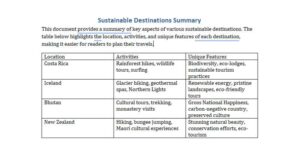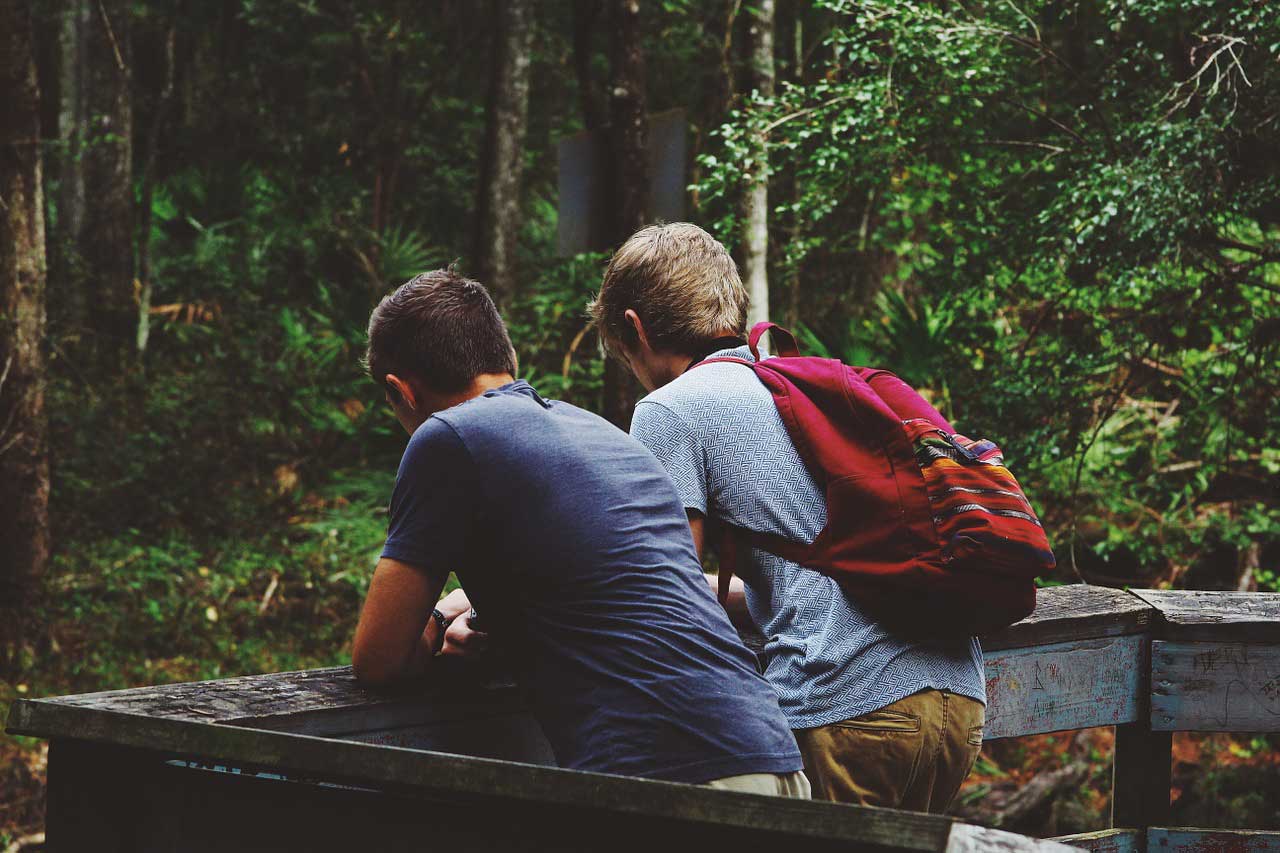What if your next adventure could protect the planet and deepen your experience? Are you ready for Sustainable Travel in 2025 with purpose?”
Thesis Statement: Sustainable travel is not just an ethical imperative but a transformative approach to exploring the world that enriches our experiences, protects our planet, and supports local communities. This guide provides practical strategies and insights to help you travel more responsibly and meaningfully.
Introduction
Sustainable travel is more than just a trend; it’s a necessity in our world. As concerns about climate change and the impact of tourism grow, it’s critical to travel in a way that is mindful of the environment and local communities. This beginner’s guide will provide you with practical steps to make your travels more sustainable in 2025 and beyond, addressing the why and how of responsible travel.
Why Sustainable Travel Matters
Choosing sustainable travel is a powerful way to make a positive impact. It’s about being a responsible traveler who cares about the planet, people, and places visited. It’s a balancing act between maximizing the positives of travel while reducing or eliminating the negatives. Here’s why it matters:
- Protect our Planet: Travel, particularly air travel, contributes to greenhouse gas emissions. By opting for sustainable transport, you can reduce your carbon footprint and help protect the planet.
- Support Local Communities: Tourism can have both positive and negative impacts. Sustainable Travel in 2025 prioritizes supporting local businesses, preserving cultural heritage, and ensuring that tourism benefits local people. This leads to economic growth and the preservation of traditions. Initiatives like Fair Trade Tourism help promote fair wages and working conditions, fair purchasing and operations, equitable distribution of benefits, and respect for human rights, culture and the environment.
- Enhance Your Travel Experience: Sustainable travel encourages slower, more immersive experiences that connect you with local cultures in meaningful ways. It allows for a richer and more authentic travel experience and can boost your well-being.
- Preserve Natural Beauty: Overtourism can degrade natural environments. Sustainable practices help minimize our impact on fragile ecosystems, protecting wildlife, reducing pollution, and conserving natural resources.
- Boost Your Well-being: Slow travel and immersion in local cultures and nature can have a positive impact on your mental and emotional well-being. It can be an escape from the daily grind and a reconnection with the world around us.
Overtourism: A Growing Concern
While tourism offers many benefits, it’s important to be aware of tourism’s negative impacts. This occurs when too many visitors strain local resources, infrastructure, and the environment. This can lead to environmental damage, social and cultural issues, and a negative impact on the visitor experience. While the tolerable number of visitors differs from place to place, overtourism occurs when the negative impacts of tourism outweigh the positive. This happens when the number of visitors exceeds a destination’s capacity, considering its resources, infrastructure, and community well-being. Tulum, Mexico, is one example of a destination facing these challenges due to rapid development and mass tourism, which has led to deforestation and water pollution.

How to Sustainable Travel in 2025: Practical Tips and Tricks
Now that you understand why sustainable travel matters, let’s explore practical ways to make your trips more eco-friendly and responsible:
Choose Sustainable Transportation
- Think Beyond Flying: Air travel is carbon-intensive. Consider alternatives like trains, buses, or carpooling. For shorter distances, walk or cycle.Or plan a “staycation” or local excursions.
- Fly Mindfully: If you must fly, choose direct flights and airlines with carbon offset programs or those investing in sustainable aviation fuels.
- Embrace Public Transport: Use public transport at your destination to save money and experience the city like a local.
- Utilize Technology: Consider services like Japan Airlines “Any Wear, Anywhere” clothes-sharing service to reduce luggage weight and emissions.
Choose Sustainable Accommodation
- Support Eco-Friendly Hotels: Look for hotels with certifications like Green Seal, LEED, or EarthCheck. Click here for a list to start you off.
- Consider Locally Owned Options: Stay in locally owned guesthouses or homestays to support the local economy and enjoy an authentic experience.
- Be Mindful of Your Resource Use: Conserve water and energy by taking shorter showers and turning off lights when you leave your room.
- Seek Out Unique Eco-Lodges: Stay in eco-lodges like Foresight Eco Lodge in Tanzania or Casa Corcovado Jungle Lodge in Costa Rica, which are designed to minimize their environmental footprint.
Pack Light and Smart
- Pack Light: The heavier your luggage, the more fuel your plane or train will consume. Pack only what you need and choose versatile items.Use packing cubes, lightweight materials, and rolling clothes instead of folding them.
- Choose Sustainable Packing Materials: Opt for a durable, eco-friendly suitcase made from recycled materials.
Minimize Waste and Plastic Consumption
- Ditch Single-Use Plastics: Bring your own reusable water bottle, coffee cup, and shopping bag. Consider solid toiletries.
- Say No to Unnecessary Freebies: Leave those hotel pens and notepads behind.
- Support Businesses That Minimize Waste: Choose restaurants and cafes that use reusable containers and cutlery.
Support Local Communities
- Eat Local: Dine at locally owned restaurants and try traditional dishes.
- Shop Local: Buy souvenirs from local artisans and craftspeople.
- Respect Local Customs: Learn about local traditions and etiquette. Dress respectfully and be mindful of your behavior.
- Engage in Community-Based Tourism (CBT): Participate in tourism activities planned and managed by local communities.
- Take Photos Mindfully: Ask permission before taking photos, especially of children. Avoid exploitative or disrespectful images.
Minimize Your Impact on the Environment
- Stay on Marked Trails: When hiking, stick to designated paths to avoid damaging ecosystems.
- Respect Wildlife: Observe animals from a distance and avoid disturbing their behavior.
- Leave No Trace: Pack out all trash and leave the environment as you found it.
Embrace Slow Travel
- Slow travel encourages taking your time, immersing yourself in the local culture, and savoring the journey.
- It reduces transportation emissions, supports local businesses, and fosters cultural immersion.

Sustainable Activities and Experiences
Sustainable travel isn’t just about how you get there and where you stay; it’s also about the activities you choose:
- Visit Local Markets: Find unique souvenirs, sample local produce, and interact with vendors.
- Take a Cooking Class: Learn to prepare traditional dishes and experience local cuisine.
- Participate in Eco-Tours: Choose tours that support local conservation efforts.
- Volunteer with Local Organizations: Give back to the community by volunteering with organizations that protect the environment.
- Visit Cultural Heritage Sites: Explore historical landmarks and learn about local culture and history. Click here for some famous landmarks.
Addressing Ethical Dilemmas and Controversies
- The ‘Sustainability’ Burden: The responsibility for sustainable travel lies on travelers, the travel industry, governments, and international organizations.
- Greenwashing: Be aware of companies using misleading eco-friendly claims. Seek certifications, transparent practices, and avoid excessive marketing rhetoric. Support organizations genuinely committed to sustainability.Learn more here.
- Cultural Sensitivity: Be mindful of cultural appropriation. Learn local basic phrases and respect local customs and traditions.
- Balancing Preservation and Access: Manage tourist flows by visiting less popular destinations or going during off-peak seasons. Respect any rules to protect natural resources.
Technological Innovations for Sustainable Travel
- Carbon Offsetting Apps: Use apps to compensate for the environmental impact of travel.
- AI-Powered Route Planners: Utilize route planners that prioritize public transport.
- Blockchain: Support transparent and ethical tourism services.
Behavioral Psychology for Sustainable Choices
- Framing: View sustainable choices as appealing and convenient.
- Incremental Changes: Start with small, manageable changes to promote more sustainable practices.
Accessibility for All
- Ensure facilities and transportation are accessible to people with disabilities and other marginalized groups.
- Promote welcoming and inclusive local communities.
The Role of Policy
- Advocate for policy changes that incentivize eco-friendly practices in businesses.
- Support regulations to minimize negative impacts on the environment.
- Encourage international cooperation for global sustainability standards.
Future Research Directions and Emerging Trends
- Regenerative Tourism: Explore tourism that creates positive impacts such as habitat restoration and community empowerment.
- The Impact of AI: Discuss how AI can optimize travel routes, manage tourist flows, and promote sustainable practices.
- Personalized Sustainability: Tailor travel to individual preferences using tools to create personalized sustainability plans.
- Post-Pandemic Travel: Promote a slower, more intentional approach to travel post-COVID-19.
- Measuring Impact: Track your impact and monitor your travel activities.
- Behavioral Interventions: Use interventions such as commitment devices and social norms to encourage travelers to make sustainable choices.
Sustainable Travel Destinations and Accommodations
Looking for inspiration? Here are some options:
- Costa Rica: Known for eco-resorts like Rancho Margot.
- Norway: Explore fjords on eco-friendly ships or stay at Svart, the world’s first energy-positive hotel.
- New Zealand: Go whale watching with Whale Watch Kaikoura, a Maori-owned business.
- Bolivia: Stay at Chalalán Ecolodge in the Amazon rainforest, run by the Quechua-Tacano Indigenous community.
- Romania: Visit Libearty Bear Sanctuary in Transylvania, a refuge for rescued bears.
- Kansas City, USA: The city has a free streetcar system that connects popular neighborhoods.
- Calgary, Canada: Calgary’s CTrain light rail system is powered by 100% wind-generated electricity.

Conclusion: Travel Better, Together
Sustainable Travel in 2025 is not about giving up travel; it’s about making conscious choices that minimize our impact and maximize the benefits for local communities and the environment. By following these tips, you can explore the world responsibly and contribute to a more sustainable future for tourism. Remember, every small step counts.
Call to Action: Start planning your next sustainable adventure and share your experiences with others to inspire them to travel better. Join the movement of responsible travelers committed to protecting our planet.
For more information and resources on sustainable travel, check out these websites:
- Sustainable Travel International: https://sustainabletravel.org/
- The World Travel & Tourism Council (WTTC): https://wttc.org/
- Ecobnb: https://ecobnb.com/
Strive To Be
PHYSICALLY STRONG … MENTALLY AWAKE … ENVIRONMENTALLY SAFE

Why is sustainable travel important, and what are its core principles?
Sustainable travel is important because it mitigates the negative impacts of tourism on the environment, local communities, and cultural heritage. It’s about responsible travel that protects the planet, supports local economies, preserves natural beauty, and enhances the travel experience. The core principles are reducing your carbon footprint (especially from air travel), respecting and supporting local communities, minimizing waste and plastic consumption, and engaging with destinations in a way that benefits both the traveler and the place being visited.
How does overtourism negatively affect destinations, and what is an example of a place experiencing these problems?
Overtourism occurs when a destination receives an excessive number of visitors, straining its resources, infrastructure, and environment. This leads to environmental damage (pollution, waste, habitat destruction), social issues (displacement of locals, increased prices, erosion of local culture), and a degraded visitor experience (overcrowding, noise, less authentic atmosphere). Tulum, Mexico, exemplifies overtourism with its deforestation, water pollution, and strain on local resources due to rapid development and mass tourism.
What are some practical transportation alternatives to flying, and what can I do when flying is necessary?
Alternatives to flying include trains, buses, carpooling, walking, or cycling for shorter distances. If flying is necessary, choose direct flights to reduce emissions, and select airlines with carbon offset programs or those investing in sustainable aviation fuels. Using public transport at your destination is also crucial. Japan Airlines, for example, offers an “Any Wear, Anywhere” clothes-sharing service, allowing travelers to rent outfits instead of packing bulky luggage, which reduces plane weight and fuel consumption.
How can I choose eco-friendly accommodations, and what should I consider while staying there?
Look for accommodations with certifications like Green Seal, LEED, or EarthCheck, indicating a commitment to energy efficiency, water conservation, and waste reduction. Consider locally owned guesthouses or homestays for an authentic experience and direct support to the local economy. While staying anywhere, conserve water (shorter showers, reuse towels), turn off lights and air conditioning when leaving your room, and generally minimize resource use. Unique eco-lodges, designed to minimize environmental impact and support local projects, offer immersive nature experiences, such as Foresight Eco Lodge in Tanzania and Casa Corcovado Jungle Lodge in Costa Rica.
What are effective ways to reduce waste and plastic consumption while traveling?
Reduce waste by ditching single-use plastics. Instead, bring reusable water bottles, coffee cups, and shopping bags. Consider solid toiletries like shampoo bars and toothpaste tablets to minimize plastic packaging. Decline unnecessary freebies like hotel pens and notepads. Support businesses that minimize waste by choosing restaurants that use reusable containers and cutlery.
How can I support local communities during my travels, and why is it important?
Supporting local communities ensures that tourism benefits the people who live there. Eat at locally owned restaurants, purchase souvenirs from local artisans and craftspeople, and respect local customs and traditions by researching etiquette beforehand and dressing respectfully. Engage in community-based tourism (CBT) experiences, which are planned and managed by locals, ensuring the benefits stay within the community. Ask permission before taking photos, especially of children.
What does it mean to embrace slow travel, and how can this practice contribute to sustainability?
Slow travel is about taking your time to immerse yourself in the local culture and savor the journey, rather than rushing through a long list of attractions. This reduces transportation emissions by minimizing frequent flights or long car journeys. It supports local businesses for a longer duration, which increases economic opportunity in a community. Further, slow travel fosters cultural immersion, allowing for meaningful connection with the local life.
What are some examples of sustainable travel destinations and activities that I might consider?
Consider destinations renowned for their commitment to sustainability, such as Costa Rica (eco-resorts), Norway (eco-friendly fjord cruises, energy-positive hotels), New Zealand (indigenous-owned eco-tours), Bolivia (indigenous-run Amazonian ecolodges), and Romania (bear sanctuaries). Sustainable activities include visiting local markets, taking cooking classes, participating in eco-tours that support conservation, volunteering with local organizations, and exploring cultural heritage sites. You can also consider staying at places like Rancho Margot in Costa Rica, Svart in Norway, or Chalalán Ecolodge in Bolivia.




